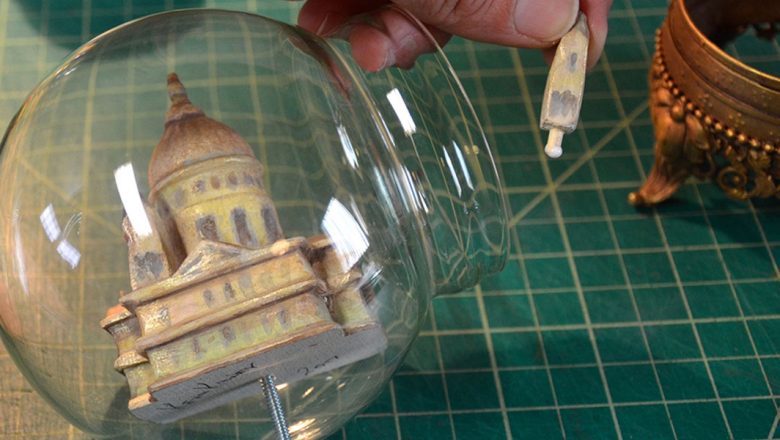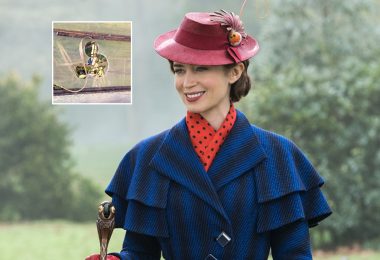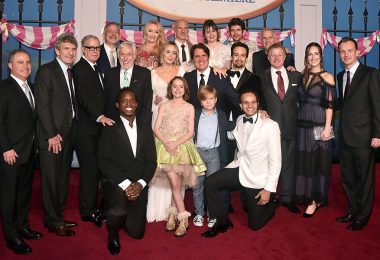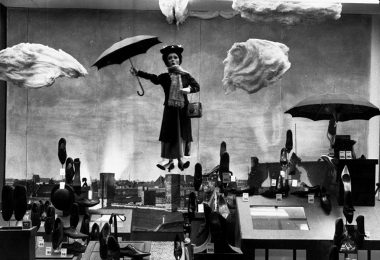By Jim Frye
“I honestly can’t remember why we kept most of this stuff to begin with,” says a grown-up Michael Banks, as he sifts through long-forgotten keepsakes in Mary Poppins Returns. He pauses to look at an old snow globe, dried out and bruised with age, but fans of the original film immediately identified the item as a key piece from the original 1964 film. A heartwarming reminder of St. Paul’s cathedral and the Sherman brothers song “Feed the Birds,” beloved by audiences and Walt Disney himself.
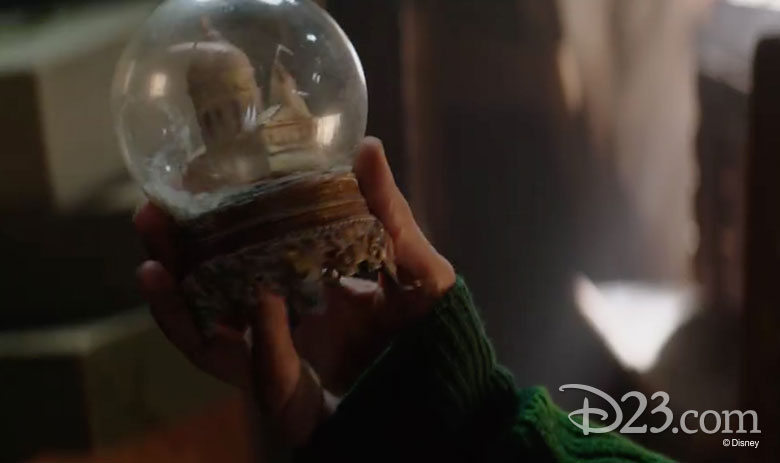
The 50-plus-year journey of that snow globe from the first film to the sequel is a noteworthy tale, involving the efforts of many people, all coordinated through the Walt Disney Archives. “One of the most special moments of Mary Poppins Returns was our visit to the Walt Disney Archives,” says John Myhre, production designer for the film. “Rob Marshall and I are lifelong Disney fans and the thought of actually seeing real props from the first film was overwhelming.” Archivist Kevin Kern guided the filmmakers through decades of Poppins history and artwork, while his colleague Rick Lorentz escorted them through the museum-like facility on The Walt Disney Studios’ Burbank lot.
Myhre continues: “Delicately laid out on the table was Mary Poppins’ carpet bag, some toys from the children’s room—including the blocks that spell out her name—and the St. Paul’s snow globe. Being over 50 years old, the snow globe had lost its water. It was beautiful and had a haunted lost memory feel to it. Rob knew instantly that it needed to be included in the attic set where Ben Whishaw, as Michael, finds memories from his past.”
The fact that the snow globe made it into the Archives in the first place is a pretty remarkable story itself, as recounted by Disney Legend and Walt Disney Archives founder Dave Smith: “Shortly after I founded the Archives in 1970, I started searching through attics, closets, basements, and storerooms to find any items or files that I felt had historical value and should be in the Archives,” Smith says. “The basement of the Animation Building held a treasure trove, with hundreds of boxes and file cabinets stashed down there and forgotten. Everywhere things could be stored, they were. There were even huge air-conditioning ducts in which boxes had been placed when there was no space for shelving.”
One day, while speaking to head janitor Roy Geysor in his office, Smith happened to notice something interesting on a shelf above Roy’s desk. “Looking closer, I realized that it was the actual snow globe containing a model of St. Paul’s cathedral in London which had been used as a prop in Mary Poppins. I asked Roy if he knew what it was, and he said no, that he had just found it in the trash one day and thought it looked cute.”
Rescued from the trash(!) and then recovered from the janitor’s shelf, the beloved prop became part of the Archives collection. “We’ve had the snow globe ever since the Archives started,” says current Archives director Becky Cline. “It doesn’t have water in it and the base was missing, but it has the little birds.”
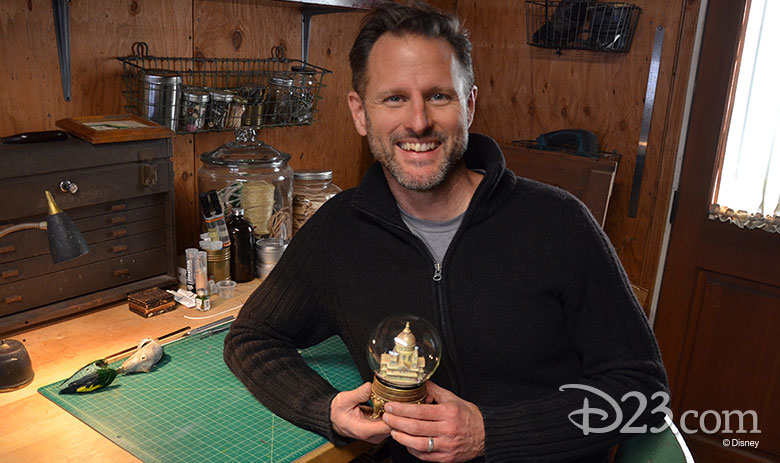
To re-create that base, Cline hired well-known designer Kevin Kidney in 2007. No stranger to designing for Disney, Kidney has worked on everything from theme park show props to collectible merchandise. “The original snow globe was handmade by one of my art heroes—Disney Legend Rolly Crump,” says Kidney. “The glass portion with the cathedral was on display in the Archives, but the metal base had been missing for nearly 50 years. I was able to re-create it from production stills and screen shots.”
It’s that snow globe—with its re-created base—that the Mary Poppins Returns filmmakers saw. Together with the archivists, however, they deemed the original globe too delicate to transport to London for use in the film, so, on the recommendation of Cline, they instead hired Kidney to re-create it. “With the help of the archivists I obtained photographs and measurements of the 1964 prop, and matched the colors and paint treatment for the miniature cathedral,” says Kidney. “For Mary Poppins Returns, I was tasked to build the entire snow globe—cathedral, birds, and all—but without water.”

The Archives’ Nick Vega provided photographs and specific measurements for the task. The first step was to rough out the miniature cathedral using tiny pieces of basswood. The simple wooden form was then coated in a thin layer of epoxy putty and hand-painted. After painting, the big challenge was getting the cathedral to fit through the glass globe’s two-and-a-half-inch opening. “I wish I had Mary Poppins’ skills in packing a carpet bag,” cracks Kidney. “Fitting St. Paul’s Cathedral through the globe’s opening was challenging.” The main section had to be slid in at a sideways angle and, once inside the globe, the two towers could be attached using pliers—similar to building a ship in a bottle. The base that supports the globe is made of three metal bands curled into a cylinder shape and decorated with antique jewelry pieces and custom-sculpted parts. The entire surface was then brushed with a series of washes so the metal would look aged and patinated.
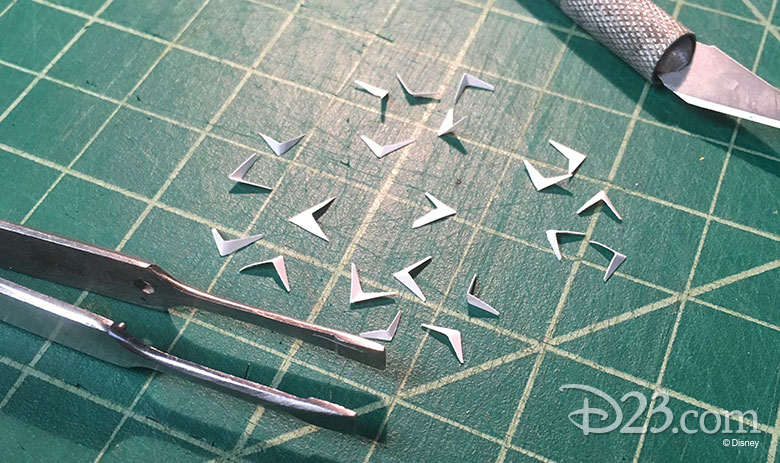
“In the movie, the globe is discovered by grown-up Michael Banks in the cluttered attic of the Banks House,” says Kidney. “John Myhre explained that they placed it in the attic because ‘that’s where Jane and Michael’s childhood went.’ Though it’s only onscreen for a brief moment, the snow globe is instantly familiar to generations of Poppins fans, and it had to be spot-on.”
It was definitely instantly familiar to Dave Smith: “When I saw Mary Poppins Returns,” says Smith, “I was thrilled to see that, sure enough, there was a snow globe based on that original one I found almost 50 years ago.”
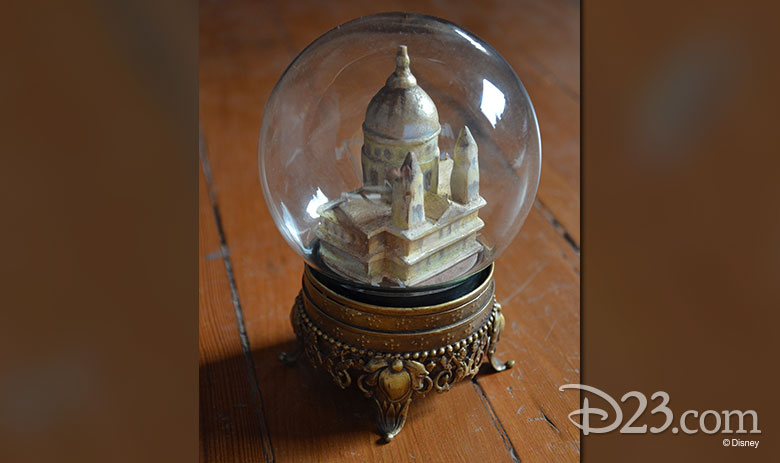
That old snow globe has definitely gone on a yeoman’s journey—first appearing at 17 Cherry Tree Lane in the 1964 film, then miraculously surviving a trash bin before landing on a janitor’s shelf only to be re-discovered and preserved by the Walt Disney Archives, and finally re-created for a whole new generation of Mary Poppins-loving fans. It’s just as Emily Blunt, as Mary, sings in Mary Poppins Returns, “Nothing is gone forever, only out of place.”



